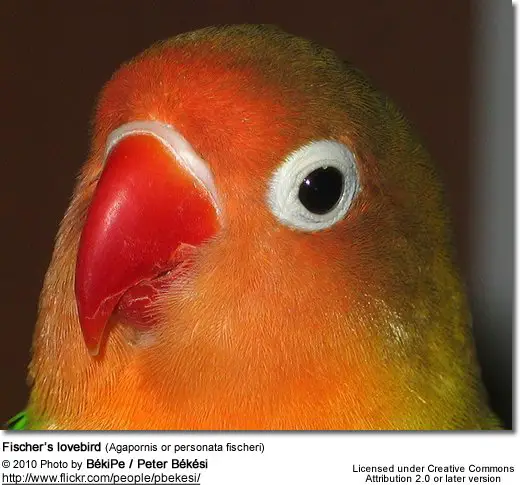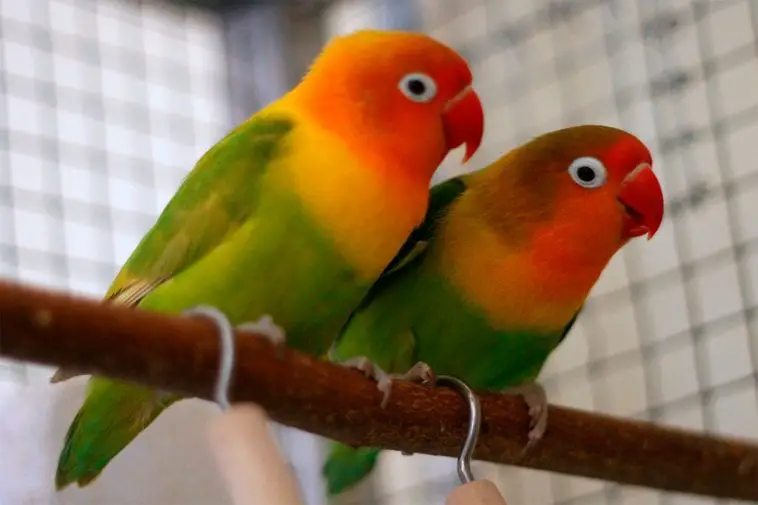Scientific Facts
| Common Name | Fischer’s Lovebird, Fischer Love Bird, Fisher Lovebird |
| Scientific Name | Agapornis Fischeri |
| Size | 6 inches |
| Life Span | 10 – 20 years. |
| Habitat | Grasslands and savannah |
| Country of Origin | Central Africa |
Fischer’s lovebird has a fairly attractive character though he might not occur as famous as the more prevalent peach-faced lovebird. The Fischer’s is inferior in notoriety to the peach-faced lovebird; however, they are not inferior in temperament.
They can be a little valuable than the standard peach-faced lovebird, particularly the more limited modifications, which are considerably familiar with lovebird enthusiasts.
Physical description
The Fischer’s Lovebird is a little tinier lovebird. They have a broad green feather that is more yellowish below. The throat, forehead, and cheeks are orange-red, and the rest of the cranial is dark olive green. The upper breast and neck are a golden yellow. The tail has some black and yellow blocking and light blue plumage on the upper portion. The eye is brown encircled by a barren white eye-ring. The bill is red, and the limbs are light gray. The juveniles are darker, particularly on the cranial, and they possess black impressing on the nose.

These small lovebirds seem indistinguishable to their relatives, the Nyasa Lovebird. Numerous innocent spectators obtain it challenging to know the distinction between the two species; though, it gets clear once the difference is confirmed. A Fischer’s Lovebird holds a blue display during which a Nyasa Lovebird makes not.

The Fischer’s Lovebird relates to a flock of lovebirds termed the ‘eye-ring’ species. There are four eye-ring species, with the other three being the Masked Lovebird the Nyasa Lovebird A. p. Liliane, A. p. personata, and Black-cheeked Lovebird A. p. nigrigenis. This flock can be distinguished by the apparent substantial loop around their eyes.
It is tricky to separate between females and males as they resemble virtually equal. Some skilled growers can vividly mate the lovebirds through their head form, volume, and temperament; though, the most dependable method to discover the sex of the lovebird is through bearing embryos or DNA sexing.
These species are intimately linked and will propagate easily if retained mutually. It is firmly recommended that you have these species isolated to sustain their essential forms, as reproducing within each species itself creates gorgeous shade modifications.
Size – Weight:
The Fischer’s Lovebird is a tad tinier than the other lovebird species, barely reaching up to approximately 5 3/4″(14.5 cm) in height.
Geographical Range

They are endemic to a little region of east-central Africa, south, and southeast of Lake Victoria on the inland plateaus of northern Tanzania. Some lovebirds migrate west into Burundi and Rwanda, exploring more humid requirements in dryness times.
They are comfortable to have and propagate smoothly in confinement. They can be reproduced in huge territories. They were incipiently found in the late 1800s and 1926 in the United States they were originally hatched.
Habitat
The natural territory of these lovebirds is central Africa, but there are other sultry areas where you can spot Fischer’s lovebirds as well. Though, these birds are identified for possessing their distinct inclinations. These birds are though accustomed to the fundamental conditions that they dwell in but, likewise, relish the peaceful living at the homestead.
Common Behavior
Fischer can be meager though they are curious, inquisitive, bold, and difficult to track down. Numerous individuals assume lovebirds get in couples since they frequently view pictures of two lovebirds fondled up toward one another. No uncertainty, a lovebird, frequently creates a profound connection with another lovebird. Likely handlers must be knowledgeable, though, that a lovebird couple should prefer not to socialize with humans, as they will be completely absorbed on each other. A single lovebird partner requires loads of friendly interplay with the humans in his/her career, as well as lots of lively activity in the form of games and secure things to grind up and damage. A female lovebird can get extremely protective of her region (enclosure).
Speaking Abilities:
Fischer’s lovebirds have adequately sufficient articulating abilities. They unquestionably can speak; however, they do not desire to chat. These lovebirds are not deemed to be enormously of speakers. They do fancy socializing with modern humans, though have restrained expression. Similar to small birds, they are not extremely inclined to speaking relentlessly.
In contrast to chatting, these lovebirds are more attached to acquiring extra tricks. They can impersonate other humans and discover distinct responses from other individuals. Furthermore, these birds have a grand passion for chanting and wheezing. They can study various melodies by merely attending to them. Therefore, it wouldn’t be wicked to state that the lovebirds are much of songbirds than speakers!
Biting and Aggression:
Fischer’s lovebirds are acknowledged as signifying the least disruptive or brutal, in correlation to any other lovebirds. The tranquil and gentle character of these lovebirds presents them much adorable. The serene character of these lovebirds is likewise added cause why these lovebirds are not threatening. They do not manage to possess offensive aura within them.
Nevertheless, the absence of hostility does not suggest that these lovebirds won’t ultimately snap. These lovebirds hold a sense of chewing as a response to something, quite similar to all other birds. Nibbling for parakeets is a means to display their diverse sentiments.
Therefore, if Fischer’s lovebirds snap, it indicates they are irritated or not satisfied with something. But it will discover to restrain the snapping response as well if you train the bird not to snap.
Diet and Feeding Habits
Seedy food: Fischer’s lovebirds stuff chiefly on grains and periodically on dropped beans and berries. Sometimes they charge growing yields (millet and maize), and their flights can expand to numerous hundred birds, so growers regard them annoyances. The lovebirds likewise necessitate sipping water every day.
Video Url: https://www.youtube.com/watch?v=kN8BfnOCzyM
Heavy drunkards: Fischer’s lovebirds exist near water reservoirs, as they must drink regularly. They are resistant to move and will solely do so if water gets inaccessible. They can be spotted near water basins, on scorching times (which is frequently), where they can quench their dryness during the day.
Reproduction and Life Cycle
The bird will produce four to six eggs, which are nursed for approximately 23 days. The juvenile becomes adult and abandons the cradle in roughly 3 to 3 /12 weeks; however, it will yet be helpless until nearly a month of generation. When they grow self-sufficiently, transfer the juvenile to their distinct home.
Life Span
The lifespan of Fischer’s lovebirds is, indeed, conditioned on the variety of menu and nourishment they acquire in their existence. However, these lovebirds do not possess a very extensive lifespan, even on a healthy intake. Lovebirds are species of birds that are notorious for possessing long days and can exist up to the term of 90 years!
Nevertheless, Fischer’s lovebirds will remain up to lasting solely 15 years optimum. The life cycle of these lovebirds will unmistakably rely on what variety of balance nourishment they receive.
How to Breed
Video Url:
The mating period is January through April and June through July. The embryos are white, normally three to five in a clasp. Males serve their partners while the female nurtures the embryos, and both origins supply the juveniles. This kind of parenting behavior is general among lovebirds. Kids become adults at approximately five weeks of age.
These lovebirds are a favorite in birdhouses of breeders or amateurs because of their gentle character and severity of breeding. A birdhouse of 52 square ft (1.5 m3) is adequate if one desires to reproduce no higher than three couples of Fischers. Their responsiveness to freezing conditions is typical of the whole species inside this family.
The nominal heat for grown-up birds is 50F (10C ), while juvenile birds must not be held in less than 60F (15C). If one chooses to place them outdoors throughout the winter, it is necessary to bequeath them retreats so the birds may obtain some shade. In the studios with regulated heats, breeding persists throughout the whole year.
Throughout the breeding period, birds must be presented with sufficient supply to create a cradle. Twigs of withy are the most proper as they give the moisture required for standard incubating of youngsters. The cradle of 7 in (18 cm) diameter and expansion and 8 in (20 cm) in elevation may be caught with withy twigs so that even individuals cannot progress the bird. The female normally grips 3 to 6 eggs. Reproduction remains for 20 days.
Subsequent 45 days, the juveniles are self-sufficient and can be segregated from their progenitors. They remain up to 35 days following delivery in the cradle. Over the succeeding ten days, the manner of separation emerges. A significant measure of aggregates will block cannibalism. Further than three offspring a year is not suggested to protect the birds from accidental burnout.
Pet Care
Housing
Notwithstanding their tropic environments, grown-up Fischer’s Lovebirds can remain in conditions as below as 10°C (50°F).
If you reside someplace warm and consume a portion of living in your backyard, you may need to contemplate having your Fischer’s Lovebird outside.
Though, they mustn’t be dropped solely for lengthened terms. That’s why you must only grant outside installation if you can stand near their side for the most utmost of the day; conversely, if you’ve had a couple of lovebirds. They will profit from the clean draft but must be retained in a predator-safe cage (don’t overlook predators can tunnel below enclosures).
You may even want to carry them inside at nightfall to prevent night-loving predators from taking them. Though, when it’s freezing, it’s most beneficial to accommodate them inside.
The essential matter to master is to positively not hold lovebirds in a cage solely, make certain there are a couple, a male and a female. An excellent enclosure would be of measurements 45x45x30 cms, with the rails separated at no larger than 2cms. They are perceived to have obtained their passage out of the enclosure on incidents, so the access of the enclosure must no be before-mentioned that the bird can penetrate effortlessly.
Enclosures should be washed regularly, with a comprehensive sanitizer, while the water and food bowls must be accomplished at least once a week.
Roosts of numerous measurements, frames, and surfaces (metallic or wooden) must be presented, along with papers and toys, the latter since it is one the Fischer lovebird’s preferred pieces to nibble on, particularly through the mating season, which, for confined lovebirds, ultimate year-round.
Feeding
Feeding a pet lovebird a nutritious menu is essential. Lovebirds manage to be extremely choosy regarding consuming exotic meals. For this logic, breeders must present the youngest lovebirds to all varieties of foods at an initial period, so they acquire to savor a mixture of spices. If the pet lovebird declines to attempt different meals, the master must maintain to supplement fresh meals regularly as the lovebirds will ultimately begin to consume it.
These lovebirds must be furnished with the core nutrition of pellets or seeds. Most lovebird blends in a retail pet shop will serve, though the lovebirds should discover to consume grains as well since they carry loads of nourishments not located in grains. It can get terms for the lovebird to consume pellets, and the master must be composed and consonant when presenting them to the grain diet. Not merely are pellets and seeds necessary, so are raw vegetables and fruits.
Lovebirds require possessing their food stripped or diced into tiny pieces because they cannot handle the meat as properly as bigger birds. Parts such as apples, broccoli, spinach, or carrots require to be alternated the entire week.
Care
The Fischer’s lovebird likes to shower every day; this can be achieved by equipping them with a level ceramics bowl supplied with water, or utterly by sprinkling them with warm water. They adore to refine themselves by sustaining their nails and beaks; therefore, if you have presented them with several frame roosts, the bird will take responsibility for itself.
Safeguards
Because these lovebirds are inquisitive, added cares must be exercised when your lovebird is outside of his enclosure. They are meager and can simply be walked on. They can likewise take into daily home materials that can get them seriously sick or induce mortality. These lovebirds require to be trained to perform on their platforms and not be prompted to ramble off. How can that be achieved? Every moment your lovebird chooses to leap off his station, tenderly put him back. It merely needs several periods before he catches his limits. It is essential to be one measure advanced of your lovebird; they are extremely curious and can quickly take into a struggle.
Skills
Fischer’s Lovebirds can perform various skills. However, they cannot manage things with one leg; they can still swing, swivel around, and put things into cartons. The number of know-how that your lovebird can achieve is extensive; it merely needs tenacity and endurance by the master. The master must be imaginative as these lovebirds can acquire numerous articles and will cheerfully present skills for recognition or feasts.
Availability
If you desire a gentle and friendly pet, purchasing a handfed Fischer’s Lovebird is classic. They cover anywhere from $45.00 – $130. The amount varies on where the lovebirds are obtained. Lovebirds raised in an aviary are more affordable though not approved if the master commands to manage the bird.
Purchasing a handfed bird can be slightly more costly; though, the reward can be excellent. A handfed bird enables the master to supervise it with more comfort and do for better-friendly pets as they are accustomed to living around humans. These birds reproduce quickly, so attaining a social breeder must not be complicated. If a neighborhood breeder cannot be located, pet shops likewise market Fischer’s Lovebirds.
Purchasing a handfed bird from a licensed pet shop can be a bit challenging. Though, if you order a bird that is not handfed, merely understand that it will need some moment and struggle to train and to make the lovebird get along.
Attempt and attain a legitimate breeder when obtaining a Fischer’s Lovebird. You can locate a noble breeder through gossiping or by inquiring about individuals that are in the business. Before you purchase your bird, it’s essential to guarantee your lovebird is accurately trained. A correctly conditioned lovebird will not be modest and will warmly appreciate the synergy with you. This does not imply that they will not be a bit bashful as they oblige to become accustomed to their current masters; however, it does indicate that they will be more accessible to pets.
The breeder must have already removed the junior bird, including being trained well. The infant should consume a mixture of diet to guarantee maximum well-being. Begin to slowly include leafy greens, vegetables, or fruits into his nutrition; if your lovebird does not devour moist foods. Setting a course within the enclosure regularly will urge them to undertake it, though most of Fischer’s Lovebirds will not consume different meals. The solution here is patience and persistence.
Conservation Status
Endemic populations may be threatened by the enclosed bird (pet) business, as well as the bird cross-breeding with the Yellow-collared lovebird, whereas the Fischer’s lovebird is still prevalent in some regions, and huge figures are retained as pets throughout the globe.
Additional Facts
- In the late 19th century, the Fischer’s lovebird has been titled following the person who found the species, Gustav Fischer, a German explorer.
- The genus title of the lovebird, Agapornis, is a blend of two Greek words, ‘agape’ signifying love, and ‘ornis’ importing bird.
- This is the third most promptly accessible of the entire lovebird species subsequent to the yellow collared and the peach-faced species.
FAQs
Are Fischer lovebirds loud?
While not as loud as any bigger birds, lovebirds can still create a harsh, high pitched shriek, particularly when they’re asking your care.
Can Fischer lovebirds talk?
Lovebirds (in common) are not recognized for their speaking capability, although some lovebirds do acquire phrases.
Why do Lovebirds die?
It is assumed that once lovebirds are matched, they are coupled for the season. Normally, if one spouse perishes, the other departs too because of heartbreak. There are several causes such as poisoning, loss because of unexpected panic
How do I know if my lovebird is happy?
Purring can be a symptom of inconvenience though it might suggest your lovebird is comfortable and satisfied, so thoroughly observe the body gesture that appends this noise. Lovebirds likewise make various pleasant noises that can show they are in great condition.
Can 3 lovebirds live together?
Classify them, either toward their enclosures or within 1 couple and 1 single bird.
Can 2 female lovebirds live together?
Lovebirds can be special regarding their partners, but two female lovebirds can link and become a couple, it commonly results when two female lovebirds accidentally dwell mutually.



